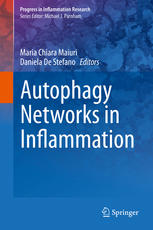Autophagy Networks in Inflammation 2016
دانلود کتاب پزشکی شبکه های اتوفاژیک در مورد التهاب
| نویسنده |
Daniela De Stefano, Maria Chiara Maiuri |
|---|
| تعداد صفحهها |
403 |
|---|---|
| نوع فایل |
|
| حجم |
7 Mb |
| سال انتشار |
2016 |
89,000 تومان
اتوفاژی در درجه اول یک عملکرد تطبیقی برای محافظت از ارگانیسمها در برابر بیماریهای مختلف انسانی، از جمله سرطان و تخریب عصبی انجام میدهد. پیشرفتهای اخیر با استفاده از مدلهای in vitro، ex vivo و in vivo، دخالت مسیر اتوفاژی در ایمنی و التهاب را نشان میدهد. علاوه بر این، برهمکنش مستقیم بین پروتئین های اتوفاژی و مولکول های سیگنال دهنده ایمنی نیز نشان داده شده است. نقص در اتوفاژی – مشابه سرطان، بیماری های عصبی و پیری – از طریق جهش ژن اتوفاژی و/یا تضاد میکروبی، ممکن است زمینه ساز پاتوژنز چندین بیماری عفونی و سندرم های التهابی باشد. علیرغم آگاهی روزافزون از اهمیت اتوفاژی در این شرایط پاتوفیزیولوژیک، این فرآیند کم ارزش باقی مانده و اغلب نادیده گرفته می شود. در نتیجه، نقش آن در شروع، پایداری، نگهداری و پیشرفت این بیماری ها به خوبی شناخته نشده است. این کتاب به بررسی پیشرفتهای اخیر در مورد عملکرد مسیر اتوفاژی و پروتئینهای اتوفاژی در ایمنی و التهاب، با تمرکز بر نقش آنها در تمایز اتوفاژی، و پیامدهای آنها برای پاسخهای ایمنی ذاتی و سازگار و اختلال در تنظیم آنها در برخی بیماریهای التهابی و خودایمنی میپردازد. بیماری ها
Autophagy principally serves an adaptive function to protect organisms against diverse human pathologies, including cancer and neurodegeneration. Recent developments using in vitro, ex vivo and in vivo models show the involvement of the autophagy pathway in immunity and inflammation. Moreover, direct interactions between autophagy proteins and immune signalling molecules have also been demonstrated. Defects in autophagy - similar to cancer, neurodegenerative diseases and aging - through autophagy gene mutation and/or microbial antagonism, may underlie the pathogenesis of many infectious diseases and inflammatory syndromes. In spite of the increasing awareness of the importance of autophagy in these pathophysiological conditions, this process remains underestimated and is often overlooked. As a consequence, its role in the initiation, stability, maintenance, and progression of these diseases are still poorly understood. This book reviews the recent advances regarding the functions of the autophagy pathway and autophagy proteins in immunity and inflammation, focusing on their role in self-nonself distinction, their implications in innate and adaptive immune responses and their dysregulation in the pathology of certain inflammatory and autoimmune diseases.




